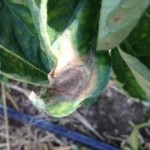General: The common theme that was impacting fruit, vegetable and agronomic field crops this week was waterlogged, saturated soils as a result of all the rainfall we have had recently. Depending upon the specific crop this is going to have impacts that will range from plant death, to root rots, to fruiting disorders, to reduced yields and secondary plant diseases. (See photo below)
Fruit:
Overall both apples and peaches are still looking good although scouts did note a large increase in both European red mite and 2-spotted spider mites on some varieties of apples. Populations were large enough that miticide treatments were recommended. In the small fruit area strawberry harvest is approaching an end, while some red raspberries will soon begin harvest, and some blueberry varieties also have ripe berries. Grapes are developing fruit which are approximately pea-sized at this point. Scouts are monitoring and trapping for spotted wing drosophila fruit flies and all trap counts are negative at this point.
Vegetables:
The biggest issue that scouts are running into is high tunnel management with tomatoes. Tomatoes are ripening and harvest is underway in some tunnels, but some growers need to work on opening up the tunnel to get more air movement and to reduce some of the high relative humidity that can be present. Scouts have noted leaf mold, early blight, sclerotina timber rot, blossom end rot and yellow shoulder in high tunnel tomatoes. (See photo below) Field grown tomatoes are at flower and fruit set with no disease problems currently being reported.
Onions and garlic are developing well in the majority of fields. This past week scouts did find yellow stripe virus, a potyvirus, in garlic. A couple of onion fields have some purple blotch (alternaria), while thrips have remained below treatment threshold level.
Growers have treated for cucumber beetle pressure in squash, pumpkins, zucchini and melons and treatment has been effective as scouts have noted the presence of dead beetles. Other fields have reached threshold level and will need to be treated.
Green snap beans are at a range of development stages as staggered planting continues. Some early plantings are just at harvest ready. Common pest problems include slugs, bean leaf beetle leaf feeding and flea beetles. Currently all pests are below threshold levels.
Sweet corn is another crop at various development stages due to staggered planting and growth stages range from V-1 to tassel and silking. Black cutworm leaf feeding is still being detected at low levels not exceeding 10%, while European corn borers feeding damage and larvae are being found. (See photo below)
Many potatoes are in flower and tuber development. Colorado potato beetles is at or above threshold levels in some fields and in others control treatments have been successful in bring beetle numbers down.
Agronomic Field Crops:
Soybeans: The big concern voiced from scouts was ponding and saturated soils. This is a particular concern in soybeans where in many of the fields the crop just seems to be standing still and is not advancing in growth stage. Some damping off has been observed in some portions of some soybean fields. Insect pests present include slugs, flea beetles, bean leaf beetle and Japanese beetles. None at threshold level.
Corn: Corn ranges in development from V-1 to V-9. European corn borer feeding evidence is being found in traited corn, but no live larvae are found. In non-traited corn, European corn borer feeding varies from slight to one field where 49% of the plants sampled showed symptoms of feeding damage. Water ponding is a concern in many fields. Also slug damage is being noted on the lower leaves and slug can be found in areas of heavy fodder. (See photo below)
Alfalfa: Rains are delaying second harvest. Potato leaf hopper (PLH) counts increased this week, averaging between 1 and 9 PLH adults and nymphs per 10 sweep sample, but since alfalfa height is averaging between 15 to 30 inches, these numbers are still below threshold. Other insects noted by scouts include pea aphids, alfalfa plant bug, tarnished plant bug and Japanese beetles. None are at threshold levels.
Photos by Chris Smedley and Austin Pelyak




